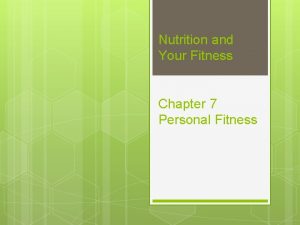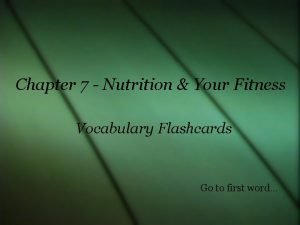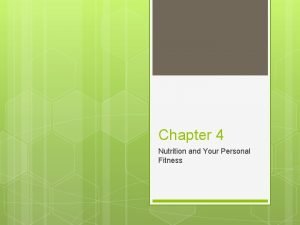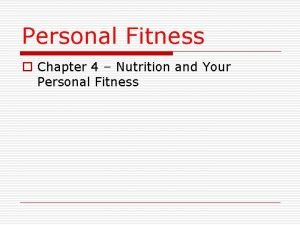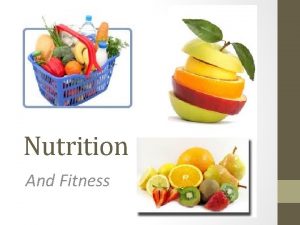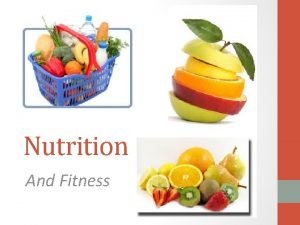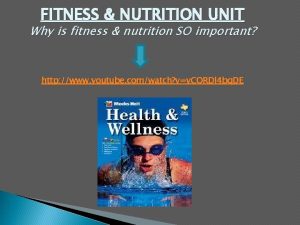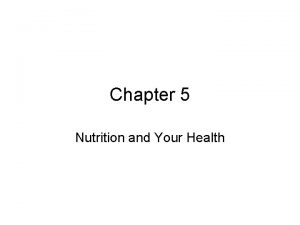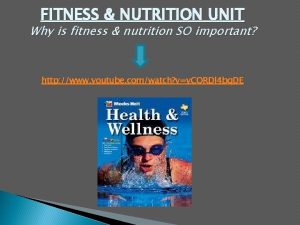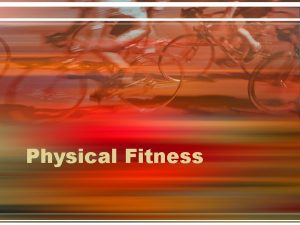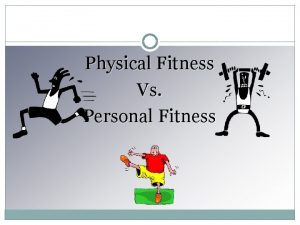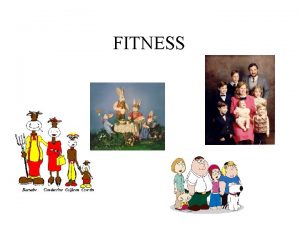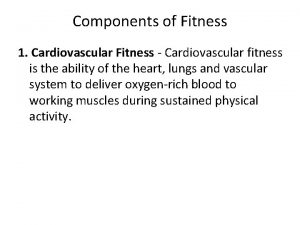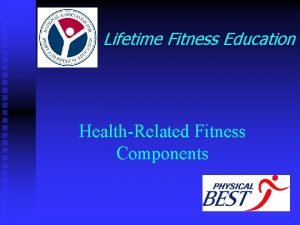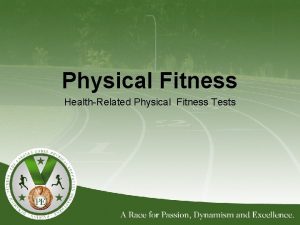Chapter Seven Nutrition and Your Fitness Nutrition and

















- Slides: 17

Chapter Seven Nutrition and Your Fitness

Nutrition and Achieving High Level Fitness The foods you eat form the foundation of your health & fitness. Food provides: ä Fuel (energy) ä Stamina and vigor for daily activities ä Basis for sound, healthy skin, teeth, hair, muscles and bones

Six Essential Nutrients ä Carbohydrates ä Protein ä Fats ä Minerals ä Vitamins ä Water

Proteins 10 -15% 40 -60 grams/day Carbohydrates 45 -65% 200 grams/day Fats 20 -35% 40 -73 grams/day 10% saturated <20 grams Mostly from complex carbs Only 10% from simple carbs

Carbohydrates ä Function: Major source of energy, supplies fiber ä Food Sources: Fruits, vegetables, grains ä Recommended Percentage in Diet: 45 -65% mostly from complex carbohydrates rather than simple carbohydrates

Proteins ä Function: Important for growth, maintenance, repair of tissue ä Food Sources: Chicken, fish, meat, low-fat dairy products, eggs, dried peas, beans ä Recommended Percentage in Diet: 10 -35%

Fats ä Function: Source of stored energy, provide and carry the fat soluble vitamins (ADEK) ä Food Sources: ä ä ä Monounsaturated fat - olive oil, canola oil Polyunsaturated fat - safflower oil, corn oil, liquid margarines Saturated fat - meat, butter, milk, solid shortenings Trans Fat - cookies, crackers, French fries, donuts Recommended Percentage in Diet: 20 -35% - trans fats and saturated fats combined should be less than 10% of the total

Cholesterol ä ä A waxy, fatty-like material manufactured in the body and used by the body in chemical processes. Found in foods of animal origin. Excess cholesterol is deposited on the lining of the arteries. Narrowing of arteries can lead to cardiovascular problems.

Cholesterol Two Types of Cholesterol ä High Density Lipoproteins - HDL ä ä Good cholesterol, picks up extra cholesterol and eliminates it from the body Low Density Lipoproteins - LDL ä Bad cholesterol, contributes to clogging of arteries by depositing the extra cholesterol on the lining of the arteries

Fiber ä ä Structural part of plants which is neither digested nor absorbed by the body Serves as an intestinal “house cleaner” Best sources are fruits, vegetables, grains, and cereals. Fiber is not found in animal foods.

Sugar Intake ä Eating honey, sugar, soft drinks, candy bars or any sweets does not provide quick energy. ä To maintain a consistent energy level, eat a diet high in complex carbohydrates (grains, cereals, vegetables)

Minerals ä Function: Important in activating numerous reactions within the body ä Food Sources: Varies with the specific minerals - a variety of foods is necessary ä Recommended Percentage in Diet: Adequate intake indicated by the RDA

Vitamins ä Function: Aid in absorbing and using the nutrients. Each vitamin has one or more specific functions in the body. ä Food Sources: Varies with the specific vitamins - a variety of foods is necessary ä Recommended Percentage in Diet: Adequate intake indicated by the RDA

Vitamin Supplements ä ä Taking vitamin supplements cannot compensate for a diet that is deficient in nutrients. Those who may need a vitamin supplement: ä ä Dieters who take in less than 1, 200 calories People with food allergies who cannot eat certain foods Vegetarians who do not eat animal foods Heavy smokers or heavy drinkers

Water ä Function: Provides a medium within the cells in which the chemical reaction of the cells takes place; helps regulate body temperature, digest food, excretion, glandular secretion ä Food Sources: Beverages and liquids in food ä Recommended Percentage in Diet: Two to three quarts daily

Dietary Reference Intake ä ä Recommended Dietary Allowance (RDA) amount necessary to meet nutritional needs Adequate Intake (AI) - guideline used to help set dietary goals Estimated Average Requirement (EAR) - amount needed for special groups Tolerable Upper Level Intake (UL) - the safe upper limits for nutrients

Nutrition & Your Fitness Gain an understanding of nutrition basics so that you can develop a nutrition plan that will contribute to lifelong fitness and wellness. Return to Chapter Menu
 Seven nutrition and fitness
Seven nutrition and fitness Chapter 7 nutrition and your fitness
Chapter 7 nutrition and your fitness Chapter 7 nutrition and your fitness
Chapter 7 nutrition and your fitness Chapter 4 nutrition and your personal fitness
Chapter 4 nutrition and your personal fitness What is skill-related fitness? *
What is skill-related fitness? * The seven deadly sins
The seven deadly sins Chapter 12 lesson 4 fitness safety and avoiding injuries
Chapter 12 lesson 4 fitness safety and avoiding injuries Chapter 12 lesson 2 improving your fitness
Chapter 12 lesson 2 improving your fitness Fitness & nutrition
Fitness & nutrition Fitness & nutrition
Fitness & nutrition Fitness & nutrition
Fitness & nutrition Fitness & nutrition
Fitness & nutrition Fitness & nutrition
Fitness & nutrition Fitness & nutrition
Fitness & nutrition Fitness & nutrition
Fitness & nutrition Chapter 5 lesson 1 health
Chapter 5 lesson 1 health Fitness chapter 6
Fitness chapter 6 Give us your hungry your tired your poor
Give us your hungry your tired your poor

